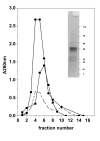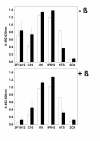Antibody recognition of the glycoprotein g of viral haemorrhagic septicemia virus (VHSV) purified in large amounts from insect larvae
- PMID: 21693048
- PMCID: PMC3148207
- DOI: 10.1186/1756-0500-4-210
Antibody recognition of the glycoprotein g of viral haemorrhagic septicemia virus (VHSV) purified in large amounts from insect larvae
Abstract
Background: There are currently no purification methods capable of producing the large amounts of fish rhabdoviral glycoprotein G (gpG) required for diagnosis and immunisation purposes or for studying structure and molecular mechanisms of action of this molecule (ie. pH-dependent membrane fusion). As a result of the unavailability of large amounts of the gpG from viral haemorrhagic septicaemia rhabdovirus (VHSV), one of the most dangerous viruses affecting cultured salmonid species, research interests in this field are severely hampered. Previous purification methods to obtain recombinant gpG from VHSV in E. coli, yeast and baculovirus grown in insect cells have not produced soluble conformations or acceptable yields. The development of large-scale purification methods for gpGs will also further research into other fish rhabdoviruses, such as infectious haematopoietic necrosis virus (IHNV), spring carp viremia virus (SVCV), hirame rhabdovirus (HIRRV) and snakehead rhabdovirus (SHRV).
Findings: Here we designed a method to produce milligram amounts of soluble VHSV gpG. Only the transmembrane and carboxy terminal-deleted (amino acid 21 to 465) gpG was efficiently expressed in insect larvae. Recognition of G21-465 by ß-mercaptoethanol-dependent neutralizing monoclonal antibodies (N-MAbs) and pH-dependent recognition by sera from VHSV-hyperimmunized or VHSV-infected rainbow trout (Oncorhynchus mykiss) was demonstrated.
Conclusions: Given that the purified G21-465 conserved some of its most important properties, this method might be suitable for the large-scale production of fish rhabdoviral gpGs for use in diagnosis, fusion and antigenicity studies.
Figures



References
-
- Wagner RR. The rhabdoviruses. Plenum Press NY. 1987. p. 543.
-
- Klepfer SR, Debouck C, Jacobs A, Bollen A, Jones EV. Characterization of rabies glycoprotein expressed in yeast. ArchVirol. 1993;128:269–286. - PubMed
-
- Kurath G. Biotechnology and DNA vaccines for aquatic animals. Rev Sci Technol. 2008;27:175–196. - PubMed
LinkOut - more resources
Full Text Sources
Other Literature Sources
Research Materials

